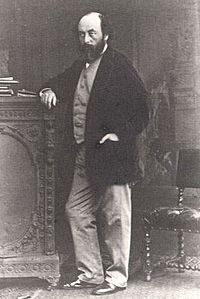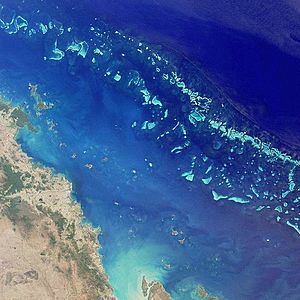Joseph Jukes facts for kids
Quick facts for kids
Joseph Beete Jukes
|
|
|---|---|

Joseph Beete Jukes, circa 1860
|
|
| Born | 10 October 1811 Summer Hill, Birmingham, England
|
| Died | 29 July 1869 (aged 57) |
| Resting place | St Mary's, Selly Oak, Birmingham |
| Nationality | British |
| Alma mater | St John's College, Cambridge |
| Known for | Geology of Newfoundland |
| Scientific career | |
| Fields | Geology |
| Institutions |
|
| Doctoral advisor | Adam Sedgwick |
Joseph Beete Jukes (born October 10, 1811 – died July 29, 1869) was an important British geologist and explorer. He was born in Summer Hill, Birmingham, England. Jukes wrote several books about geology and worked as a naturalist on the famous HMS Fly expeditions. His friends often called him Beete Jukes.
Contents
Early Life and First Expeditions
Joseph Jukes was born in 1811. He went to school in Wolverhampton and Birmingham. Later, he studied geology at St John's College, Cambridge with Professor Adam Sedgwick.
Exploring Newfoundland
Between 1839 and 1840, Jukes traveled to Newfoundland (an island off Canada). He studied its geology and made maps. He wrote a book called Excursions In and About Newfoundland During the Years 1839 and 1840. This book shared all his discoveries from his time there.
Voyage on HMS Fly
In 1842, Jukes joined the corvette HMS Fly as a naturalist. The ship's mission was to map and survey areas like the Torres Strait, New Guinea, and the east coast of Australia. The expedition was led by Francis Price Blackwood.
The HMS Fly visited many places and sailed around Australia twice. It also went to the island of Java in 1845. Jukes wrote a detailed account of these journeys in his book, Narrative of the Surveying Voyage of H.M.S. Fly. This book included his observations about nature and the people he met.
One important part of his book was about the Great Barrier Reef. His writings about the reef are considered a classic in Australian geology. The information Jukes collected there also helped support Charles Darwin's ideas about how coral reefs form.
Discovering Australia's Geology
One of Jukes's most important works for Australia was A Sketch of the Physical Structure of Australia. This book included the very first complete map of the Australian continent.
Mapping Australia
Jukes created this map using many notes and his own observations. He studied the coastline, visited different parts of Australia, and read what other explorers had written. From all this information, Jukes drew a picture of Australia's geology.
He noticed that Australia's landscape seemed very uniform. Mountain ranges and rock formations often stretched for many miles without much change. However, Jukes also realized that Australia's land was rich in minerals. In 1846, he suggested that more geological surveys should be done in areas like New South Wales and Van Diemen's Land (now Tasmania).
Jukes's work gave some of the first real insights into Australia's geology. At that time, not much was known about the continent. His discoveries were very important to England, which was keen to learn more about the land.
Later Career and Legacy
Jukes returned to England in 1846. Soon after, he got a job with the geological survey of Great Britain. He first worked in North Wales. Then, in 1847, he began surveying the South Staffordshire coalfield. He continued this work for several years. His findings were published in his book, Geology of the South Staffordshire Coal-field (1853). This book was praised for being very accurate.
Work in Ireland
In 1849, Jukes was offered a job as a geological surveyor in New South Wales, Australia, again. But due to personal reasons, he turned down the offer.
A year later, in 1850, Jukes became the director of the Irish geological survey. He held this position for 19 years until his death in Dublin. He died after falling from a horse. He was buried in St Mary's churchyard in Selly Oak, Birmingham.
For many years, Jukes also taught geology. He lectured at the Museum of Irish Industry and later at the Royal College of Science in Dublin. He was a great teacher, and his book, Student's Manual of Geology, was a popular textbook for students in Britain.
While in Ireland, he wrote an important essay called On the Mode of Formation of some of the River-valleys in the South of Ireland (1862). In this essay, he explained for the first time how rivers form and develop. He also studied the connections between different rock systems, like the Devonian and Carboniferous rocks.
Promoting Geology
Jukes wrote many articles for geological journals. He also gave popular geology lectures in Belfast, Northern Ireland, which attracted many people. He encouraged field trips to study geology in the area. This helped lead to the creation of the Belfast Naturalists' Field Club. He also helped create a geological map of Ireland.
After he died, his sister, C.A. Browne, put together a book of his letters and talks. In 1862, a mountain in Queensland, Australia, was named Mount Jukes in his honor.
Works
Joseph Beete Jukes wrote many important books and articles, including:
- Excursions in and about Newfoundland (1842)
- Narrative of the Surveying Voyage of H.M.S. Fly (1847)
- Popular Physical Geology (1853)
- The South Staffordshire Coalfield (1853, second edition 1859)
- Student's Manual of Geology (1857)
- The article "Geology" in the Ency. Brit. 8th ed. (1858)
- School Manual of Geology (1863)
- Letters, etc., of J. Beete Jukes, edited by his sister (1871)
See also
- European and American voyages of scientific exploration


